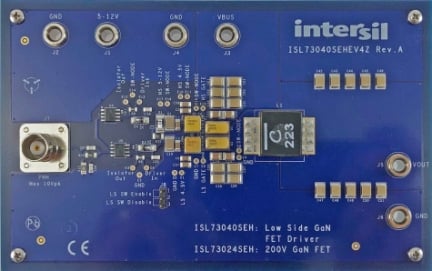Overview
Description
The ISL73040SEHEV4Z evaluation board demonstrates how to build a half bridge power stage with the ISL73040SEH low-side GaN driver and the ISL73024SEH 200V GaN FET. The ISL73040SEH has a 4.5V gate drive voltage (VDRV) generated using an internal regulator that prevents the gate voltage from exceeding the maximum gate-source rating of the ISL73024SEH GaN FET. The ISL73024SEH is a 200V GaN FET capable of 7.5A drain current.
Features
- Single PWM input to drive a half bridge configuration
- Adjustable dead time control
- Wide openings to support various inductor footprints
- >95% peak efficiency with high switching frequencies
- Enable/Disable functions
Applications
- Flyback and forward converters
- Boost and PFC converters
- Secondary synchronous FET drivers
Documentation
|
|
|
|
|---|---|---|
| Type | Title | Date |
| Manual - Development Tools | PDF 1.05 MB | |
| Datasheet | PDF 471 KB | |
| Datasheet | PDF 1.08 MB | |
| Report | PDF 349 KB | |
| Report | PDF 251 KB | |
5 items
|
||
Design & Development
Software & Tools
Product Options
Applied Filters:
Videos & Training
Renesas, a leading solution provider in the satellite and high reliability industry, discusses a technology leap into Gallium Nitride with its family of Intersil GaN products. The ISL70024SEH is designed from the ground up with space applications in mind to provide steady and reliable performance when exposed to total ionizing dose (TID) or heavy ions. The Intersil GaN driver and FET together allow more efficient switching, higher frequency operation, reduced gate drive voltage and a smaller solution size compared to their traditional silicon counterparts.
Transcript
Renesas is a leading solution provider in the satellite and high reliability industry, and is now introducing a technology leap into Gallium Nitride with its new family of GaN products.
GaN is a wideband gap material and compared to silicon, the drain to source distance can be a factor of ten smaller which translates to a much smaller RDS(on). While silicon FETs are very close to their theoretical limit of channel length, GaN has much more room for improvement. GaN's advantages to the power supply designers include size, weight and efficiency.
The size and weight reduction of using GaN over silicon comes from two factors. The first is that heat-sinking requirements are not as much due to GaN's reduced parasitics. And the second, is the use of smaller output filters due to being able to switch at higher frequencies. This allows GaN to achieve excellent efficiencies at a compact solution size.
Another plus point, when it comes to ionizing radiation in contrast to silicon FETs, GaN FETS do not have a gate oxide layer. That means radiation cannot form traps in the gate oxide that would otherwise shift the gate to source threshold voltage.
As you can see in the graph, the current technology of GaN is already orders of magnitude better and figure of merit, and this will only get better with time. To be able to take full advantage of GaN FETs, you'll need a good gate driver to go with it. So Renesas is now introducing the industry's first radiation hardened low-side GaN FET driver.
A GaN FET gate driver needs to provide a well-regulated gate voltage that never exceeds 6V under all conditions. The ISL70040SEH regulates a 4.5V gate driver in order to meet the voltage margins of the space and high reliability industry.
Here we have the ISL70040SEH low-side driver and the ISL70024SEH, the 200V GaN FET, in action. The VDD is set to 5V and the inputs are driven with a function generator set to a frequency of 500kHz. As you can see, it has fast transition times with minimal overshoot on the rising and falling edges with a well-regulated 4.5V gate drive voltage.
It is designed from the ground up with space applications in mind to provide steady and reliable performance when exposed to total ionizing dose (TID) or heavy ions. This first graph shows minimal shift in V drive, the gate drive voltage across TID for both high dose rate and low dose rate. The next graph shows how steady the operating supply current is across TID. For both gate drive voltage and supply current, we are well within the spec limits. From a single event transient perspective, at an LET limit of 86MeV, the ISL70040SEH had a very small cross section of ≤1.7 x 10-6cm2 for dynamic switching, and had no SETs for static input, high or low.
GaN FETS are a very good fit for satellite applications but require a good gate driver to realize their full potential. Together they allow more efficient switching, higher frequency operation, reduced gate drive voltage and a smaller solution size compared to their traditional silicon counterparts.
For more information, datasheets, TID/SEE test reports, or to order parts or evaluation boards, please visit our Rad Hard GaN FET product page.

